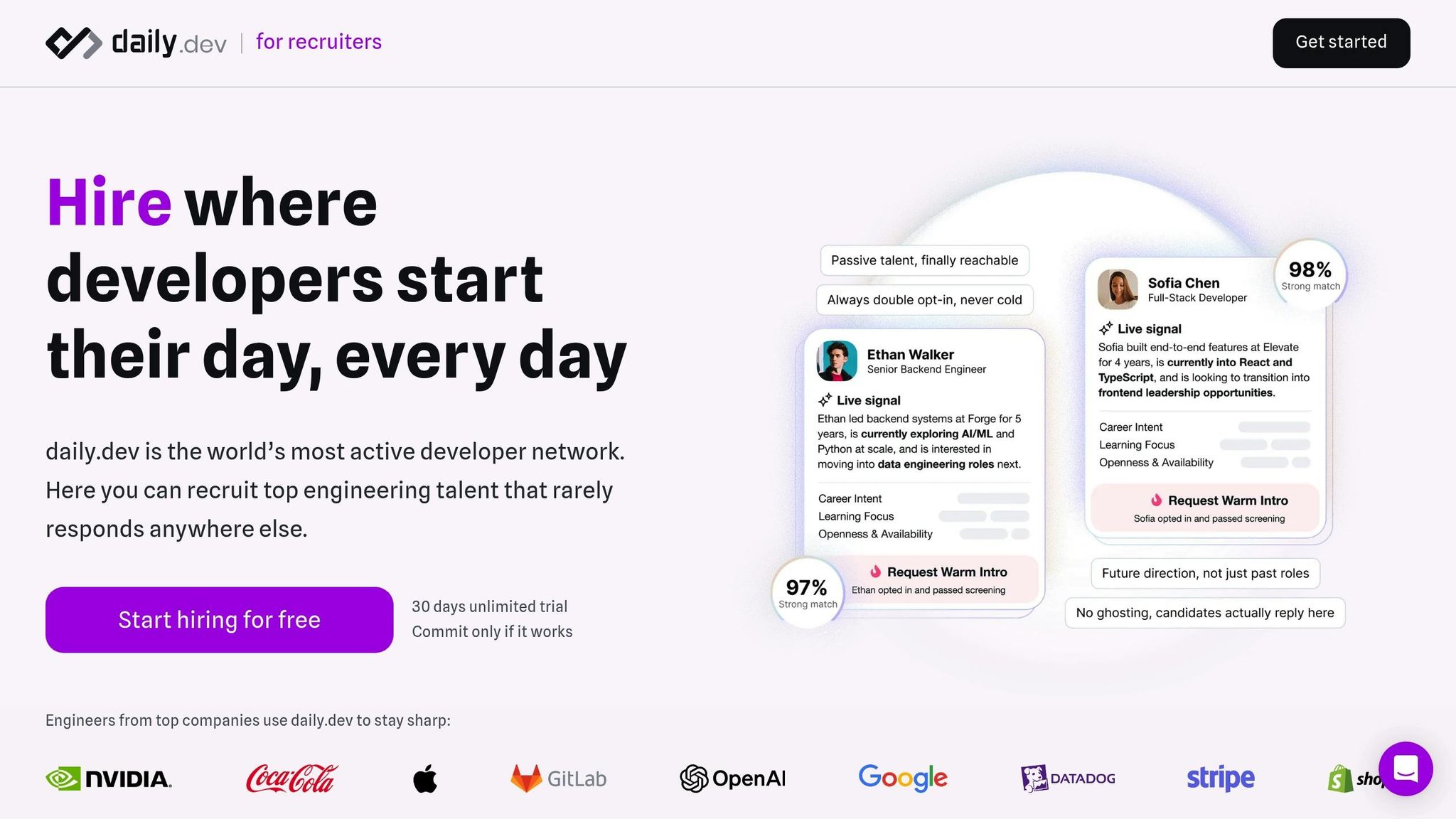


Tech recruiting costs are soaring in 2025, driven by demand, geographic factors, and the complexity of roles, making strategic budgeting essential.
Tech recruiting in 2025 is more expensive than ever, with costs ranging from $8,000 to over $28,000 per hire depending on the role and seniority. Here's why: the demand for skilled developers continues to outpace supply, driving up expenses for sourcing, tools, and onboarding. Companies are also spending more on recruiter fees and candidate engagement to stay competitive.
Key takeaways:
- Entry-level hires (e.g., software engineers) cost $8,000–$12,000.
- Senior roles can range from $16,000 to $22,000.
- Executive hires exceed $25,000, with recruiter fees making up 20–30% of the first-year salary.
- Costs are higher in tech hubs like San Francisco and New York, often 20–40% more than smaller markets.
How to control costs:
- Speed up hiring to reduce inefficiencies.
- Use developer-focused tools like daily.dev Recruiter to target pre-qualified candidates.
- Audit your recruiting budget to eliminate redundant tools and unnecessary expenses.
Recruiting smarter - not harder - is the key to managing costs while hiring top talent in a competitive market.
How The Future Hires You: 2025 Trends in Tech Student Recruitment
Main Components of Tech Recruiting Costs
Knowing how your recruiting budget is spent is key to streamlining your hiring process. Tech recruiting expenses can be grouped into several key categories, each playing a role in shaping your overall investment.
Sourcing and Advertising
A significant chunk of recruiting budgets often goes toward sourcing and advertising. This includes spending on job boards, employee referral incentives, and recruitment agencies. The costs here can fluctuate depending on factors like the platform used, the geographic reach of your search, and the level of competition in the job market.
Recruitment Technology and Tools
Modern hiring relies heavily on technology. Tools like applicant tracking systems, platforms for video interviews, coding test software, and background check services come with their own costs. These expenses depend on how extensively the tools are used and the specific features your team needs.
Screening, Assessment, and Onboarding
Screening candidates involves technical evaluations and structured interviews, which require both time and resources. Once a candidate is hired, onboarding costs - such as providing equipment and offering initial training - add to the overall expenditure.
Hidden and Indirect Costs
Beyond the obvious expenses, there are hidden costs to consider. A lengthy hiring process, the time your internal team spends on recruitment, and the risks of hiring the wrong candidate can all quietly drive up your costs.
Tech Recruiting Cost Benchmarks for 2025
Understanding recruiting costs is essential for setting realistic budgets and identifying areas for improvement. The 2025 data highlights how expenses vary significantly depending on the complexity and seniority of tech roles.
Cost Breakdown by Role
Hiring for tech positions has become more expensive, with costs increasing as roles become more specialized or senior. For entry-level tech hires, expenses generally range between $2,000 and $3,000 per hire, but for senior and executive positions, the investment climbs substantially. Here's a detailed cost breakdown by role and experience level:
| Role | Entry-Level | Mid-Level | Senior/Lead | Executive (VP/C-level) |
|---|---|---|---|---|
| Software Engineer | $8,000–$12,000 | $12,000–$16,000 | $16,000–$20,000 | $25,000+ |
| Data Scientist | $9,000–$13,000 | $13,000–$18,000 | $18,000–$22,000 | $28,000+ |
| DevOps Engineer | $8,000–$14,000 | $14,000–$18,000 | $18,000–$22,000 | $28,000+ |
| Product Manager | $6,000–$9,000 | $9,000–$12,000 | $12,000–$16,000 | $25,000+ |
These figures account for both direct costs - like recruiter fees and job advertisement expenses - and indirect costs, such as the time spent by internal teams and onboarding resources. For executive roles, expenses often exceed $28,000 due to the extensive sourcing process and recruiter fees, which can range from 20% to 30% of the first-year salary.
The cost differences stem from several factors, including role complexity, market demand, and the time required to fill the position. Specialized roles like DevOps engineers and data scientists are particularly expensive to recruit due to ongoing talent shortages in these fields.
Market Trends Impact
Recruiting costs in 2025 are also shaped by broader market trends. Economic factors, such as inflation, have driven up both direct hiring expenses and candidates' salary expectations. Additionally, the growing shortage of tech talent has intensified competition, leading companies to spend more on sourcing strategies, employer branding, and candidate engagement. These pressures have resulted in higher recruiter fees, larger referral bonuses, and increased investment in recruitment tools and technology.
Geography plays a significant role as well. Companies in tech-heavy regions like San Francisco and New York often pay 20% to 40% more per hire than those in smaller markets. This is largely due to fierce competition and the higher cost of living in these areas.
To put tech hiring costs into perspective, the average cost per hire across all industries in the U.S. is around $4,700 to $4,800. In comparison, tech roles consistently surpass this benchmark, reflecting the growing gap between demand and supply for technical talent.
sbb-itb-d1e6221
Ways to Optimize Tech Recruiting Budgets
Managing tech recruiting budgets effectively is crucial for staying competitive while maintaining efficiency. One major way to save costs is by reducing the time-to-hire - filling roles faster not only lowers recruiting expenses but also minimizes productivity losses caused by unfilled positions.
Cutting Time-to-Hire
Shortening the time it takes to hire is a smart way to reduce overall recruiting costs. Every day a position stays vacant adds extra expenses, whether from extended sourcing efforts, administrative tasks, or lost team productivity. To speed up your hiring process, try these steps:
- Use structured interviews with clear criteria to avoid unnecessary interview rounds.
- Implement asynchronous screening tools, such as pre-recorded assessments, so candidates can schedule evaluations at their convenience.
- Address bottlenecks by setting firm deadlines for feedback and ensuring hiring decisions are made promptly.
These strategies streamline the hiring process, saving time and money while keeping your recruiting budget on track.
Using Developer-Focused Tools
Leveraging developer-focused tools can also help control costs. For example, platforms like daily.dev Recruiter connect you with pre-qualified developers through warm, double opt-in introductions. This eliminates excessive outreach and unnecessary screening, ensuring a steady flow of engaged, qualified candidates. The result? A more efficient hiring process that reduces costs while improving the experience for both recruiters and candidates.
How daily.dev Recruiter Cuts Recruiting Costs

daily.dev Recruiter offers a developer-first approach that helps companies save money while improving hiring outcomes. By focusing on what developers value most, the platform eliminates inefficiencies common in traditional recruiting methods and supports hiring goals for 2025.
Features That Speed Up Hiring
One of the standout features is the warm, double opt-in introductions, which ensure both the developer and employer show mutual interest before any contact is made. This not only eliminates wasted outreach but also boosts candidate engagement rates by up to 3x, as reported in industry studies. By focusing on developers who are genuinely interested, recruiters save time and create stronger connections.
Another key feature is the use of targeted job briefs. Instead of generic job postings that attract a flood of unqualified applicants, these concise, tailored summaries are sent to pre-qualified developers. This approach results in higher response rates and significantly fewer irrelevant applications, making the hiring process much more efficient.
The platform also includes ATS integration, which automates tasks like transferring candidate data, updating statuses, and centralizing communications. This integration reduces manual administrative work by 20-30% per hire, helping recruiters avoid errors and keep the process on track. By removing bottlenecks, hiring decisions are made faster and with less hassle.
These features not only streamline hiring but also lead to meaningful cost savings.
Cost Savings Through Better Efficiency
The efficiency of daily.dev Recruiter translates directly into measurable savings. Companies using the platform report cutting time-to-hire by up to 30% and reducing sourcing costs by 20-40% compared to traditional job boards or agencies. For example, a mid-sized U.S. software company reduced its average cost-per-hire for software engineers from $12,000 to $8,000 and shortened its time-to-hire from 45 to 30 days after adopting the platform.
| Feature | Benefit | Savings Impact |
|---|---|---|
| Warm, double opt-in introductions | Higher candidate engagement, fewer wasted interviews | Reduces sourcing and screening costs |
| Targeted job briefs | More relevant applicants, faster pipeline | Lowers time-to-hire and interview costs |
| ATS integration | Streamlined workflow, less manual work | Cuts administrative overhead |
| Developer-first platform | Attracts passive, high-quality talent | Improves hire quality, reduces turnover |
| Automated status updates | Keeps all parties informed, reduces delays | Minimizes process bottlenecks |
The platform's developer-first approach is particularly effective in attracting passive talent - those who aren’t actively job hunting but are open to the right opportunity. Engaging this pool of talent improves the quality of hires and reduces turnover, leading to long-term cost savings.
HR and procurement leaders agree that platforms like daily.dev Recruiter are essential for efficiently hiring top tech talent in today’s competitive market. When your recruiting process aligns with what developers value, you achieve higher acceptance rates and lower attrition. This not only saves money upfront but also reduces long-term hiring costs, making daily.dev Recruiter a smart investment for tech recruitment.
Summary and Next Steps
Hiring for tech roles often requires a much larger budget than the national average of $4,700 per hire. For instance, bringing on a software engineer can cost anywhere from $8,000 to $20,000, while executive roles can climb to $25,000–$28,000 or more. On top of these direct costs, hidden factors like lost productivity and onboarding delays can significantly inflate the total expense. These numbers highlight the importance of factoring in both visible and unseen costs when planning your recruitment budget.
Main Points
Indirect costs, such as productivity losses, can sometimes match or even surpass direct expenses. Additionally, location and market conditions heavily influence hiring costs. In major metropolitan areas, for example, recruitment expenses can run up to 40% higher due to increased competition and the higher cost of living.
Many companies are moving away from focusing solely on cost-per-hire metrics. Instead, they are measuring recruitment ROI by evaluating factors like employee performance, retention rates, and time-to-productivity. This shift shows that investing more upfront in quality sourcing methods and tools designed for developers can lead to lower long-term costs by improving retention and speeding up onboarding. Understanding these costs is just the beginning - what follows is finding ways to optimize your spending.
Budget Optimization Steps
Start with a detailed audit of your recruitment expenses. Break down all costs, both direct and indirect, to identify areas where inefficiencies may be driving up spending unnecessarily.
Compare your spending to 2025 industry benchmarks. If your costs for hiring software engineers exceed $8,000–$20,000, look for issues like delays in screening or over-reliance on expensive agencies that could be inflating your budget.
Evaluate your recruitment technology stack for redundancies. Many companies discover they’re paying for multiple tools with overlapping features. Switching to integrated solutions can often provide the same functionality at a lower cost.
Set measurable KPIs, such as time-to-hire and quality of hire, to track the success of your optimization efforts. Reducing hiring timelines can save managers time during the interview process and help new hires become productive sooner, cutting down on both direct and indirect costs.
Lastly, make it a habit to review and renegotiate vendor contracts regularly. Staying updated on new tools and pricing models can prevent overspending on outdated systems and ensure your recruitment strategy remains cost-effective.
FAQs
What are the key factors driving up tech recruiting costs in 2025?
The rising costs of tech recruiting in 2025 can be traced to several key factors. One of the biggest challenges is the fierce competition for top-tier talent. Companies are pouring more resources into finding and connecting with highly skilled developers, making the hiring process more expensive. On top of that, the increasing use of advanced recruiting tools and platforms - though highly effective - adds another layer to the overall costs.
Candidates themselves are also reshaping the landscape. Many now expect a more tailored approach during the hiring process, along with attractive compensation packages and the option for flexible work arrangements. To keep these expenses in check, businesses should focus on fine-tuning their recruiting strategies, adopting cost-efficient tools, and staying informed about the latest industry standards and trends.
What are the best ways to cut tech recruiting costs without compromising on talent quality?
To keep tech recruiting costs in check while still bringing in top talent, companies should aim to simplify their hiring processes and utilize smart tools. One effective approach is adopting AI-powered platforms to handle tasks like sourcing and screening candidates. These tools not only save time but also cut down on the manual workload. Look for platforms that include features to enhance candidate engagement, allowing you to build meaningful connections without inflating your budget.
Another important tactic is embracing data-driven strategies. Use analytics to monitor key metrics like cost-per-hire and time-to-fill. This information can spotlight areas where you might be overspending or where processes could be more efficient. Additionally, investing in long-term relationships with potential candidates can help establish a talent pipeline, reducing the constant need for fresh sourcing efforts. By blending the right tools with strategic planning, you can make the most of your recruiting budget while staying competitive in the tech world.
Why are tech recruiting costs higher in major hubs like San Francisco and New York compared to smaller cities?
Recruiting in tech hubs like San Francisco and New York tends to come with a hefty price tag, and there are several reasons for this. First, the demand for top-tier talent in these cities is sky-high, which naturally drives up salaries and intensifies competition among companies. On top of that, the cost of living in these areas is steep, influencing everything from recruiter paychecks to office overhead.
Another factor is the investment in advanced recruiting tools and platforms needed to stand out in such competitive markets. Companies also pour resources into building a strong employer brand to appeal to candidates in these talent-saturated regions. In short, businesses in these cities often have to go the extra mile - and spend more - to source and engage the best candidates in an ultra-competitive landscape.
Related Blog Posts








